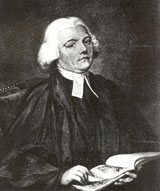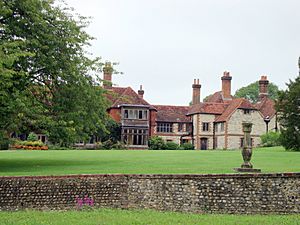Gilbert White facts for kids
Quick facts for kids
Gilbert White
|
|
|---|---|
 |
|
| Born | 18 July 1720 Selborne, Hampshire, England
|
| Died | 26 June 1793 (aged 72) Selborne, Hampshire, England
|
| Alma mater | Oriel College, Oxford |
| Known for | Natural History of Selborne |
| Scientific career | |
| Fields | |
| Influences | 'Physico-theology' of John Ray, William Derham |
| Author abbrev. (botany) | G.White |
Gilbert White (born July 18, 1720 – died June 26, 1793) was an English naturalist. He was a pioneer in studying nature, animals, and birds. He is most famous for his book, The Natural History and Antiquities of Selborne.
Contents
Gilbert White's Life Story
Gilbert White was born on July 18, 1720, in Selborne, Hampshire, England. His grandfather was the vicar (a type of priest) in Selborne. Gilbert's parents were John White, a lawyer, and Anne Holt. He was the oldest of eight children.
His family moved into a house called 'The Wakes' in Selborne in 1728. This house would be his home for the rest of his life.
His Education and Early Career
Gilbert White went to school in Basingstoke. Later, in December 1739, he went to Oriel College, Oxford. He earned his first degree in 1743 and became a Master of Arts in 1746.
He became a deacon in the church in 1746 and a full priest in 1749. He worked in several churches in Hampshire and Wiltshire. He also served in Selborne itself four times. In 1752, he held a special position at Oxford University called Junior Proctor.
After his father died in 1758, White moved back to 'The Wakes' in Selborne. He inherited the house in 1763. He continued to serve as a curate in Selborne until he died.
Gilbert White passed away in 1793. He was buried in the churchyard of St Mary's Church in Selborne.
Gilbert White: A Pioneer Naturalist
Many people see Gilbert White as one of England's first ecologists. An ecologist studies how living things interact with each other and their environment. White helped shape how we respect nature today.
The famous naturalist Charles Darwin said that White's writings deeply impressed him when he was young. White studied living birds and animals in their natural homes for many years. He didn't just study dead specimens. This was a new way to study animals, focusing on careful observation.
How White Studied Nature
White's book, The Natural History, shows a new way of studying nature. He observed animals and birds closely for almost 40 years. He realized that animals have their own feelings and behaviors.
He recorded events carefully, classified animals, measured things, and analyzed his findings. He also made deductions from what he saw and even did experiments. He was one of the first writers to describe the natural world in a personal and precise way.
For example, he wrote about house martins (a type of bird) gathering on the church. He described how they flew off together when scared, then settled back to preen their feathers in the sun. White's scientific approach was also influenced by his religious beliefs.
Observing Changes in Nature
White and another naturalist, William Markwick, recorded when over 400 types of plants and animals appeared. White made his records in Hampshire, and Markwick in Sussex, between 1768 and 1793.
These records are some of the earliest examples of phenology. Phenology is the study of how climate and seasons affect natural events, like when flowers bloom or birds migrate.
American writer Donald C. Peattie said that Gilbert White helped many people become interested in birds. White was the first to suggest counting birds. He also pioneered the idea of closely observing nature throughout the seasons. He was also the first to understand the importance of bird migration and banding birds.
White's other important contributions include:
- Developing the idea of the 'food chain', which is how living things get food from each other. This helped create the study of ecology.
- Discovering three different types of leaf warblers (small birds) by listening to their songs.
- Starting modern ideas about bird territories and how they affect bird populations.
Even today, many naturalists read White's work for his insights and discoveries. His diary from 1783–84 also describes the effects of a volcanic haze from Iceland. This haze caused big climate changes across Europe.
The Natural History and Antiquities of Selborne

White is most famous for his book, The Natural History and Antiquities of Selborne, published in 1789. The book is written as a collection of letters. These letters were supposedly sent to Thomas Pennant, a leading zoologist, and Daines Barrington, a lawyer and fellow of the Royal Society. However, some of the 'letters' were written just for the book and were never actually mailed.
This book has been printed continuously since it first came out. It was once thought to be the fourth most published book in English. Only the Bible, the works of Shakespeare, and John Bunyan's The Pilgrim's Progress were published more often.
Gilbert White's Lasting Impact
Some people thought of White as just an amateur 'country writer'. However, he is now seen as a very important person who came before great scientists like Charles Darwin. These scientists changed our understanding of life on Earth. White is also important for pioneering modern scientific research methods, especially fieldwork.
His greatest legacy was combining scientific study with an emotional connection to nature. This helped ecology grow and made people realize that humans are also part of nature.
The White family home in Selborne, The Wakes, is now the Gilbert White Museum. The Selborne Society was started in 1895 to honor Gilbert White. This society bought land in West London to create Britain's first Bird Sanctuary, called Perivale Wood. In the 1970s, Perivale Wood became a Local Nature Reserve.
Flora Thompson, a writer about the countryside, described White as "the very first of English nature writers." She said he was "the most sober and modest, yet happiest of men."
White is mentioned in books like The Once and Future King by T. H. White. A documentary about him was shown on BBC Four in 2006. He is also remembered in a stained glass window in Selborne church. This window shows St Francis of Assisi and was installed in 1920.
An exhibition called 'Drawn to Nature: Gilbert White and the Artists' celebrated his influence on artists in 2020. This marked 300 years since his birth.
White is also credited with using the word 'golly' in a journal entry from 1775. The OED also says he was the first to use 'x' to mean a kiss in a letter from 1763.
Works
- White, Gilbert (1795). A Naturalist's Calendar, with observations in various branches of natural history, extracted from the papers of the late Rev. Gilbert White of Selborne, Hampshire, Senior Fellow of Oriel College, Oxford. Never before published. London: printed for B. and J. White, Horace's Head, Fleet Street. Edited by J. Aikin.
See also
 In Spanish: Gilbert White para niños
In Spanish: Gilbert White para niños



